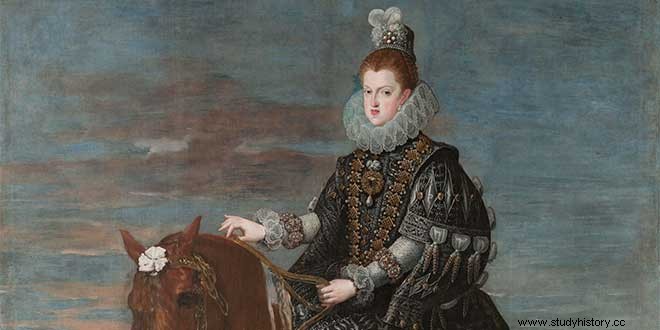Felipe III was king of the crowns of Castile, Aragon and Portugal. He was born on April 14, 1578 in Madrid. He was the son of Felipe II and his fourth wife, Ana de Austria. he was proclaimed king the same day of the death of his father, September 13, 1598; with him began the decline of the Austrian monarchy , the decline of Spain and the period of the Government of the favorites. Felipe III, unable to govern by himself, left the Government in the hands of Francisco Gómez de Sandoval y Rojas, who was his stableman; but he gave him the title of Duke of Lerma; who, being an uneducated and untalented man, took advantage of the occasion to enrich himself; To this end, he turned the Court into a market for public functions and waste, which gave rise to corruption never seen before. In addition, in order not to bother governing himself, he did the same as the king:he handed over the Government into the hands of Rodrigo Calderón, who had been his page ; but that he later became Count of Oliva and Marquis of Siete Iglesias, who ended up ruining the public treasury.
Conflicts and expulsion of Muslims
On the other hand, between 1597 and 1602, the so-called atlantic plague took place , which, in Spain, caused 500,000 deaths. In January 1601, the court of Valladolid was transferred; but, after the people of Madrid made great gifts to the King and the Duke of Lerma, the Court came to Madrid again in 1606. On the other hand, Felipe III inherited the war against England from his father; but, in 1603, Queen Elizabeth died, and her successor, James VI, made peace with Philip III in London in 1604. . The war with Flanders continued, until a twelve-year truce was signed in The Hague in 1609. Later, in order to achieve the religious unity of Spain, Felipe III decided to expel the Moors from his domains, at the request of certain dignitaries of the Catholic Church and the Duke of Lerma, who later appropriated many of their possessions. Finally, on September 11, 1609, the royal decree was published ordering all the Moors of Valencia to leave that kingdom within three days; then those from the remaining regions of Spain were gradually expelled; they all finished leaving on May 19, 1610; between 600,000 and 1,000,000 were expelled; agriculture, commerce and industry, the main occupations of the Moriscos, were paralyzed; Spain suffered a great setback.
Thirty Years War
Carlos Manuel de Saboya invaded and sacked the Milanese in 1615, for which Spain went to war against the Savoy , which, through the mediation of Louis XIII of France, ended with the Peace of Pavia in 1617. Spain also participated in the Thirty Years War , to help Ferdinand II recover Bohemia.
Conquestofnewlands
On the other hand, in this reign, the Spanish dominions abroad were increased:in America, New Mexico and the Arauco Valley were submitted; Pedro Fernández de Quirós discovered Australia in 1605 (name given in honor of the Austrians); in Asia, the kingdoms of Pegu, Candy, Termate and Teidor were conquered; and, in Africa, the squares of Mamora and Larache.
Fall of the Duke of Lerma
Finally, the Duke of Lerma fell into disgrace and, seeing himself lost, had himself granted the cardinal's hat (people said: “he dressed in red, so as not to be hanged” ), after which he said goodbye to the king and went to live in Valladolid on October 4, 1618; He was succeeded by his son, the Duke of Uceda, sharing power with the Count Duke of Olivares. The Duke of Uceda unleashed his anger against the Marquis of Siete Iglesias, who was thrown into prison and his assets confiscated.
Marriage and descendants of Felipe III
Eight children were born from his marriage to Margaret of Austria (1584-1611) in 1599:Anne (1601-1666, who married Louis XIII of France, 1601-1643), Philip IV, Mary (married to King Ferdinand of Hungary), Carlos, Ferdinand (who was a cardinal) and other children who died in infancy.

Decadence of the Spanish kingdom
In spite of the Spanish successes in the outside, in the interior the decadence began; public finances were ruined and misery had taken over Spain; Seeking a remedy, Felipe III asked the Council of Castile to draw up a report in 1619, said Council concluded that the causes of the economic ruin were:the enormous taxes that weighed on the country, the prodigality in distributing gifts and mercedes, the excess of luxury and the great number of unnecessary and venal employees; but the king, without having done anything to remedy those evils, died on March 31, 1621 in Madrid .
